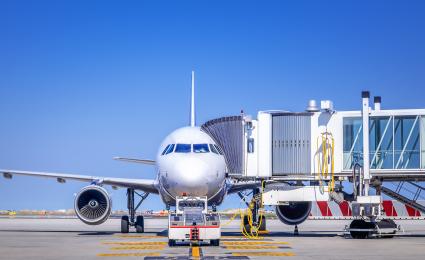Aviation companies must transform their business in order to survive. We identify key strategies and success levers for the transformation journey.


AI at the airport
What an airport customer experience could look like in the near future
Airports are complex ecosystems, composed of a multitude of stakeholders, including airlines, ground handlers, security agencies, retail and dining operators and passengers. Given the intricacy of this network, even minor disruptions can cascade into significant delays and operational challenges. Frequent causes of delays include late arrivals of passengers or bags, overcrowdedness, security breaches, unavailability of ground handling vehicles or last-minute gate changes. The summer of 2022 was exemplary for how staff shortages at European airports can trigger massive delays during the check-in, security and boarding process. When flights are missed or cancelled, it not only inconveniences passengers but also leads to a tiring and frustrating travel experience. Consequently, passengers tend to spend less time and money on the airport's retail and dining options, resulting in lost revenues for the airport.

In their ambition to reduce such disruptions in the future, more and more airports have turned towards adopting cutting-edge technologies, including advanced data analytics, robotics and the Internet of Things (IoT). The rapid advancements in Artificial Intelligence (AI) have opened up a broad range of use cases for airports to pre-empt operational disruptions, while reducing costs and even generating additional revenues. But next to the airport operator, also customers will benefit from a fully AI-enabled airport through a smoother passenger journey, as we will demonstrate in the paragraphs below:
Passenger journey
Sarah was running late. Her alarm hadn't gone off, her cat Freddy had knocked over her coffee and where did she leave her car keys again…? Her flight to Rome would be leaving soon and with the usual airport madness, she would certainly miss her flight. As she hastily scarfs down her cereals, Sarah opens GatePal, the airport’s passenger journey app, and enters the booking code of her flight. Promptly, GatePal calculates the most efficient route to the airport. Her flight is supposed to leave from a new terminal that just opened last week. She jumps into her car and drives to the airport, where she expected the usual parking nightmare. But as her car approached the entrance, the gate lifted automatically, recognizing her license plate. "Welcome Sarah!" a cheerful AI-voice greeted her. "Your reserved spot is waiting". "Well, that's a first" Sarah muttered impressed. She followed the app's directions to her parking spot, which turned out to be right next to the terminal entrance. Maybe today wouldn’t be so bad after all.
Entering the terminal, Sarah heads to the self-service check-in kiosk. With all the goodbye cuddles for her cat Freddy, Sarah completely forgot to check-in for her flight. Before she could even pull out her passport from her bag, the machine scans her face and prints her boarding pass and baggage tags in seconds. “That was quick!”, Sarah thought. As she turns around to move to the baggage drop, a robot rolls up, looking like a futuristic butler. “Allow me madam,” it said in a posh British accent. The robot swiftly scanned her luggage, ensuring it met all requirements, and whisked it away on the conveyor belt. If she only had such a thing at home to clean up her apartment, Sarah thought to herself.
While looking for the directions to the security check, Sarah notices a digital display indicating her to walk down to security check C, as the current wait time there is just less than 2 minutes. As she walks up to the security staff, she already prepares mentally for the infamous drill: Laptop out, liquids out, belt off, jewellery off, shoes off, empty pockets… “No need for that madam”, says the friendly looking security officer. “You can leave everything inside”. Relieved to have avoided the dreadful security routine, she drops her backpack onto the conveyor belt. “That’s our new state-of-the-art AI scanner!”, the officer proudly explains. “It can generate accurate 3D pictures of each bag’s content and can automatically detect dangerous objects and liquids. It makes my job so much easier”. “…and mine as well”, Sarah chuckled.
As she picks up her backpack she pauses for a moment and looks around. The airport appeared quite busy, but it did not even take her 10 minutes from the carpark to after the security check. “That’s great”, she thinks to herself. “That gives me a bit of time to do some last-minute shopping”. The moment Sarah enters the duty free shop, she receives a pop-up notification on her GatePal app. The perfume she has been eyeing at for a while now was actually on offer and reserving and paying for it through the app would give her another 5% discount! Sarah is a savvy shopper, so of course she could not let this bargain slip away.
Happy with her latest purchase, Sarah starts making her way to the exit of the duty free shop, but gets interrupted by yet another notification from GatePal. Her flight was delayed by one hour. “Well, at least I am not the only one who’s late”, she mumbles. Promptly, she receives a second notification with a 10% discount voucher for the airport’s pay-to-use lounge. “Not the worst place to kill the time and certainly a good way to start the holiday”, Sarah thinks, as she books a seat in the lounge. The moment she receives the booking confirmation, the app asks her if she requires assistance to navigate to the lounge. As Sarah has never been to this particular lounge before, she taps “Yes”. The app opens her camera and asks her to hold up her phone in front of her. A green arrow appears on the screen, indicating her to walk straight. Following the cues on the screen, Sarah arrives at the lounge 3 minutes later.
After a quick facial scan, Sarah is greeted by another futuristic robot butler. “Welcome Sarah, may I show you to your seat?”. She follows the robot to a beautiful leather armchair, right by the window, overlooking the runway. “I can see that you are flying to Rome. The pasta on our menu is exquisite. May I recommend you our spinach ravioli and a glass of Pinot Grigio to get you into the mood for your trip?”, the butler asked and of course Sarah could not say no to such an offer! About 45 minutes later, GatePal notifies her that her flight would be boarding soon and based on her current location and the location of her flight’s gate, she would have to leave in 5 minutes to arrive just in time for the boarding call of her group.
The moment Sarah arrives at the gate, a warm AI-voice calls her boarding group. But as Sarah steps forward to the facial recognition checkpoint, she cannot resist pulling a funny face. The system hesitates for a split second before a message flashes: “Nice try, Sarah. Smile for a better picture”. Sarah laughs and complies. “Have a pleasant flight, Sarah!”, the system’s AI-voice says, waving her through to the passenger bridge.
On the plane, Sarah finds her seat and settles in. Her journey through the AI-enhanced airport has been surprisingly pleasant. As the plane prepares for take off, she thinks about the day. Sure, it had started with chaos, but the AI systems had made her airport experience quite enjoyable. As she closes her eyes, ready to nap through the flight, she cannot help but think, “If only the AI could have made my cat Freddy behave this morning, it would have been a perfect day.” And with that, she drifts off, dreaming of a world where even her mischievous cat could be managed by artificial intelligence.
Value proposition
While a passenger journey like Sarah’s might still be a few years down the road, it exemplifies how AI can create value not only for passengers but can also transform the way airports operate. There are five key value propositions of using AI in airports:
First, AI can enhance safety and security by deploying advanced threat detection systems and real-time surveillance, which can quickly identify and respond to potential security risks caused by unattended luggage or suspicious behaviour.
Second, AI can play a critical role in increasing operational efficiency. As Sarah’s story exemplified, passengers can benefit from streamlined processes at check-in, security, and boarding, leading to overall lower wait times and delays. But also, behind the scenes, airports can leverage AI to increase process efficiency. Automated staffing, passenger flow and crowd management, baggage handling, predictive maintenance, airside vehicle coordination and gate allocation are just a few use cases for airports to increase operational efficiency.
Deployed right, these operational efficiency gains can yield significant cost reduction opportunities, as they aim to limit disruptions and delays, while increasing throughput and reduce staff requirements. At the same time, airports can unlock revenue opportunities by allowing passengers to spend more time and money on the airport’s retail and dining offering. Leveraging data on past shopping behaviour, AI can generate insights that empower airports to better leverage dynamic pricing and personalized marketing and sales strategies, to increase passenger spending.
Operational efficiency gains and passenger journey customization can potentially translate into an elevated passenger experience. AI-driven personalized recommendations for shopping and dining, navigation and translation services or tailored flight updates can increase passenger comfort level, for example during long layovers. Especially in regions such as the Middle East where major airports compete to be the preferred hub for connecting passengers, the use of AI can be a new USP.
Lastly, AI yields opportunities to increase sustainability at airports. On the landside, AI-driven energy consumption management can automatically adjust HCAV controls, to optimize energy use, while increasing passenger well-being. On the airside, AI can support in better coordinating aircraft movements on the apron, allowing ATCs to reduce congestion and long taxiing, thus reducing aircraft emissions.
Roland Berger offering
Roland Berger can support airports with leveraging the compelling use cases and strong value creation potential of AI. We enable our clients to succeed in this transformational journey by creating a holistic AI strategy, involving all relevant key stakeholders. To do this, we build a consortium made up of world class practitioners, IT-at-scale integrators, and niche tech partners to build the tech foundation and prepare people and organizations for the transformation.
If you would like to hear more about the use of AI in airports, we invite you to contact us or connect with Nikhil Sachdeva or Florian Dehne via LinkedIn to discuss your thoughts.
We would like to thank Lucie Stoppok, Vladimir Cabanis and Alexander Gerich for their contribution to this article.


_tile_teaser_w425x260.jpg)




_person_320.png)